Introduction
Physiotherapy in Kitchener for Elbow

Welcome to Kitchener Physiotherapy & Wellness patient resource about Cubital Tunnel Syndrome.
Cubital tunnel syndrome is a condition that affects the ulnar nerve where it crosses the inside edge of the elbow. The symptoms are very similar to the pain that comes from hitting your funny bone. When you hit your funny bone, you are actually hitting the ulnar nerve on the inside of the elbow. There, the nerve runs through a passage called the cubital tunnel. When this area becomes irritated from injury or pressure, it can lead to cubital tunnel syndrome.
This guide will help you understand:
- what causes this condition
- ways to make the pain go away
- what you can do to prevent future problems
#testimonialslist|kind:all|display:slider|orderby:type|filter_utags_names:Elbow Pain|limit:15|heading:Hear from some of our patients who we treated for *Elbow Pain*#
Anatomy
What is the cubital tunnel?
 The ulnar nerve actually starts at the side of the neck, where the individual nerve roots leave the spine. The nerve roots exit through small openings between the vertebrae. These openings are called neural foramina.
The ulnar nerve actually starts at the side of the neck, where the individual nerve roots leave the spine. The nerve roots exit through small openings between the vertebrae. These openings are called neural foramina.
The nerve roots join together to form three main nerves that travel down the arm to the hand. One of these nerves is the ulnar nerve.
The ulnar nerve passes through the just behind the inside edge of the elbow. The tunnel is formed by muscle, ligament, and bone. You may be able to feel it if you straighten your arm out and rub the groove on the inside edge of your elbow.
The ulnar nerve passes through the cubital tunnel and winds its way down the forearm and into the hand. It supplies feeling to the little finger and half the ring finger. It works the muscle that pulls the thumb into the palm of the hand, and it controls the small muscles (intrinsics) of the hand.
Related Document: Kitchener Physiotherapy & Wellness Guide to Elbow Anatomy
Elbow Anatomy Introduction
Causes
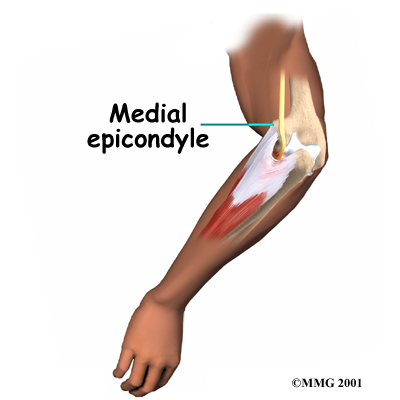 What causes cubital tunnel syndrome?
What causes cubital tunnel syndrome?
Cubital tunnel syndrome has several possible causes. Part of the problem may lie in the way the elbow works. The ulnar nerve actually stretches several millimeters when the elbow is bent. Sometimes the nerve will shift or even snap over the bony . (The medial epicondyle is the bony point on the inside edge of the elbow.) Over time, this can cause irritation.
One common cause of problems is frequent bending of the elbow, such as pulling levers, reaching, or lifting. Constant direct pressure on the elbow over time may also lead to cubital tunnel syndrome. The nerve can be irritated from leaning on the elbow while you sit at a desk or from using the elbow rest during a long drive or while running machinery. The ulnar nerve can also be damaged from a blow to the cubital tunnel.
Symptoms
What does cubital tunnel syndrome feel like?
Numbness on the inside of the hand and in the ring and little fingers is an early sign of cubital tunnel syndrome. The numbness may develop into pain. The numbness is often felt when the elbows are bent for long periods, such as when talking on the phone or while sleeping. The hand and thumb may also become clumsy as the muscles become affected.
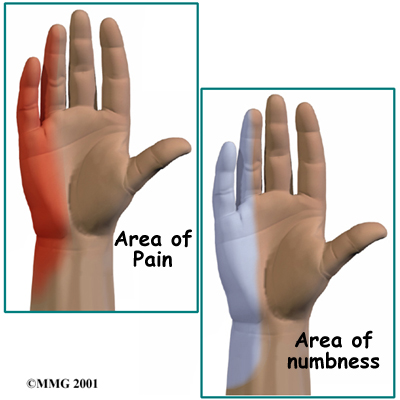
Tapping or bumping the nerve in the cubital tunnel will cause an electric shock sensation down to the little finger. This is called Tinel's sign.
Related Document: Kitchener Physiotherapy & Wellness Guide to Medial Epicondylitis
Diagnosis
When you first visit Kitchener Physiotherapy & Wellness, we will take a detailed medical history. Our physiotherapist will ask questions about how your hand is affected and whether or not you are experiencing any weakness. We will also ask you about your work and home activities and any past injuries to your elbow.
Our physiotherapist will then do a physical exam. The cubital tunnel is only one of several spots where the ulnar nerve can get pinched. We will try to find the exact spot that is causing your symptoms. The prodding may hurt, but it is very important to pinpoint the area causing you trouble.
Some patients may be referred to a doctor for further diagnosis. Once your diagnostic examination is complete, the physiotherapists at Kitchener Physiotherapy & Wellness have treatment options that will help speed your recovery, so that you can more quickly return to your active lifestyle.
Kitchener Physiotherapy & Wellness provides physiotherapist services in Kitchener.
Our Treatment
Non-surgical Rehabilitation
The early symptoms of cubital tunnel syndrome usually lessen if you just stop doing whatever activity is causing the symptoms. Anti-inflammatory medications suggested to you by your doctor may help control the symptoms, however it is much more important to stop doing whatever is causing the pain in the first place. If necessary, work with your supervisor to modify your job activities.
If your symptoms are worse at night, your Kitchener Physiotherapy & Wellness physiotherapist may advise that you wear a lightweight plastic arm splint or athletic elbow pad while you sleep to limit movement and ease irritation. You can also wear the elbow pad during the day to protect the nerve from the direct pressure of leaning.
Your physiotherapy or occupational physiotherapist will work with you to ease symptoms and improve elbow function. During your initial physiotherapy session, our physiotherapist will give you tips how to rest your elbow and how to do your activities without putting extra strain on your elbow. Our physiotherapist may apply heat or other treatments to ease pain. Exercises are used to gradually stretch and strengthen the forearm muscles.
We may show you how to do special exercises to help the ulnar nerve glide within the cubital tunnel. Treatment then progresses to include strengthening exercises that mimic your daily and work activities.
You may need to continue wearing your elbow pad or splint at night to control symptoms. You will also be encouraged to do your activities using healthy body and wrist alignment, limit repeated motions of the arm and hand, and avoid positions and activities where the elbow is held in a bent position.
If nonsurgical treatments are successful, you may see improvement in four to six weeks, although the time required for recovery is different for each patient.
When your recovery is well under way, regular visits to Kitchener Physiotherapy & Wellness will end. Although we will continue to be a resource, you will eventually be in charge of doing your exercises as part of an ongoing home program.
Post-surgical Rehabilitation
Recovery after elbow surgery depends on the procedure used by your surgeon. If you only had the medial epicondyle removed, you'll have a soft bandage wrapped over your elbow after surgery. Your physiotherapy program can progress quickly after this type of surgery. Our treatments start out with range-of-motion exercises and gradually work into active stretching and strengthening. You just need to be careful to avoid doing too much, too quickly.
Physiotherapy goes slower after ulnar nerve transposition surgery. Although the time required for recovery varies among patients, you could require therapy for three months. This is because the flexor muscles had to be sewn together to form the new tunnel. Your elbow will be placed in a splint and wrapped in bulky dressing, and your elbow will be immobilized for about three weeks.
When the splint is removed, your physiotherapy program will begin with passive movements. In passive exercises, your elbow is moved, but your muscles stay relaxed. Our physiotherapist gently moves your arm and gradually stretches your wrist and elbow. We may also teach you how to do passive exercises at home.
Active physiotherapy usually starts six weeks after surgery. We will show you how to use your own muscle power in active range-of-motion exercises. Light isometric strengthening exercises are started. You may begin careful strengthening of your hand and forearm by squeezing and stretching special putty. These exercises work the muscles without straining the healing tissues.
At about eight weeks, you'll start doing more active strengthening. Our physiotherapist will give you exercises to help strengthen and stabilize the muscles and joints in the wrist, elbow, and shoulder. We may recommend additional exercises to improve fine motor control and dexterity of the hand.
Some of the exercises you'll do are designed get your elbow working in ways that are similar to your work tasks and sport activities. Our physiotherapist will help you find ways that you can do your tasks that don't put too much stress on your elbow. Before your physiotherapy sessions end, our physiotherapist will teach you a number of ways to avoid future problems.
Kitchener Physiotherapy & Wellness provides services for physiotherapy in Kitchener.
Physician Review
You may need to see a physician for special tests used to get more information about the nerve. One common test is the nerve conduction velocity (NCV) test. The NCV test measures the speed of the impulses traveling along the nerve. Impulses are slowed when the nerve is compressed or constricted.
The NCV test is sometimes combined with an electromyogram (EMG). The EMG tests the muscles of the forearm that are controlled by the ulnar nerve to see whether the muscles are working properly. If they aren't, it may be because the nerve is not working well.
Surgery
Your symptoms may not go away, even with changes in your activities and nonsurgical treatments. In that case, your doctor may recommend surgery to stop damage to the ulnar nerve.

The goal of surgery is to release the pressure on the ulnar nerve where it passes through the cubital tunnel. There are two different kinds of surgery for cubital tunnel syndrome. It is not clear whether one operation is better than the other.
Ulnar Nerve Transposition
One method is called . In this procedure, the surgeon forms a completely new tunnel from the flexor muscles of the forearm. The ulnar nerve is then moved (transposed) out of the cubital tunnel and placed in the new tunnel.
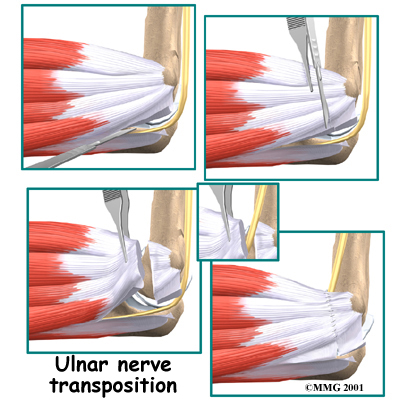
The following images show each step:




Medial Epicondylectomy
The other method simply on the inside edge of the elbow, a procedure called medial epicondylectomy. By getting the medial epicondyle out of the way, the ulnar nerve can then slide through the cubital tunnel without pressure from the bony bump.

The following images show each step:


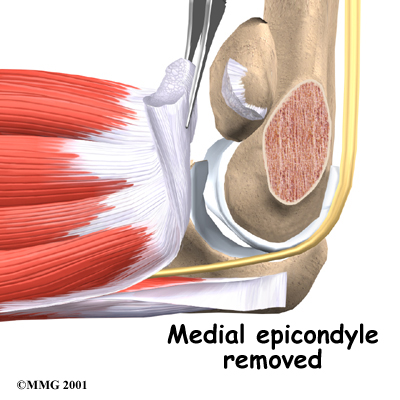

Cubital tunnel surgery is often done as an outpatient procedure. This means you won't have to stay in the hospital overnight. Surgery can be done using a general anesthetic, which puts you to sleep, or a regional anesthetic. A regional anesthetic blocks the nerves in only one part of your body. In this case, you would have an axillary block, which would affect only the nerves of the arm.
Portions of this document copyright MMG, LLC.




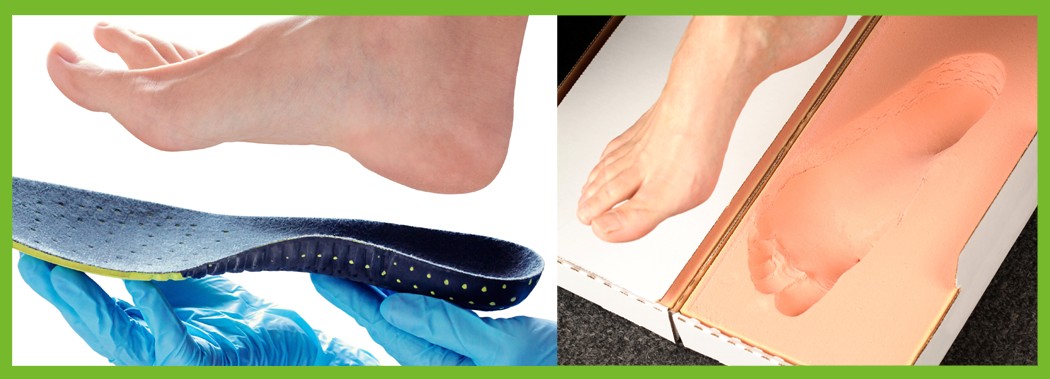






 The ulnar nerve actually starts at the side of the neck, where the individual nerve roots leave the spine. The nerve roots exit through small openings between the vertebrae. These openings are called neural foramina.
The ulnar nerve actually starts at the side of the neck, where the individual nerve roots leave the spine. The nerve roots exit through small openings between the vertebrae. These openings are called neural foramina. What causes cubital tunnel syndrome?
What causes cubital tunnel syndrome?











